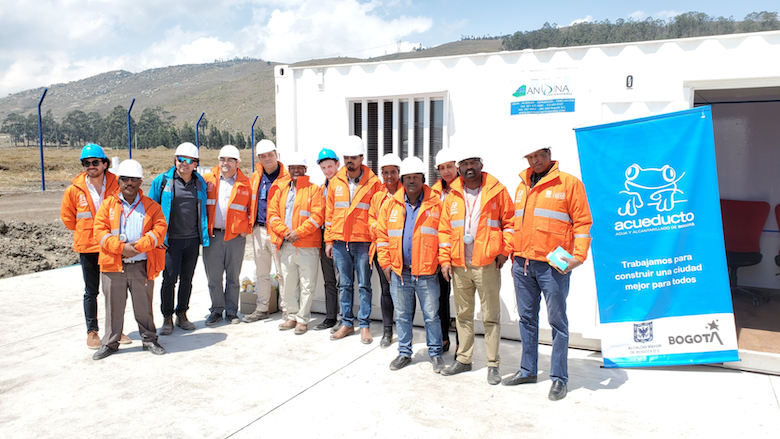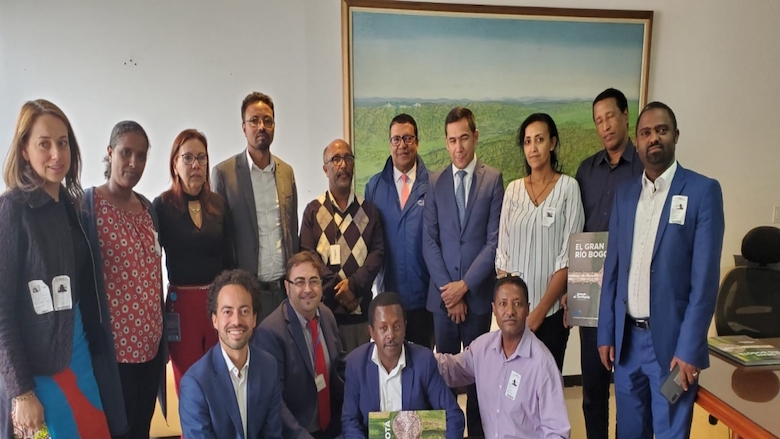A strong water supply and sanitation (WSS) sector in Ethiopia can greatly enhance human livelihoods in this East African nation. From cleaner drinking water and adequate sanitation, to better air and water quality - the benefits are clear. Thus, improving and enhancing water management, service sustainability and resilience in Ethiopia’s WSS sector is imperative.
A major contributor to degraded water quality in Ethiopia is human wastewater. One of every four Ethiopians have improved sanitation facilities and just 28 percent of the country’s wastewater is collected, treated and properly disposed or re-used. “Aside from Addis Ababa, most of our cities lack adequate wastewater management systems or management of fecal sludge…we have rivers that, to some extent, are contaminated” said Ato Bahiru Woldemariam, Assistant Director for Sanitation Infrastructure of Ethiopia’s Water Development Commission.
Despite being more than 12,000 kilometers from one another, Colombia and Ethiopia have several similarities, including relative population sizes, capital cities at high elevation and similar water challenges and opportunities.
A South-South learning exchange is one of the tools that the World Bank uses to support countries so that they can figure out how to best solve problems and design and implement sustainable solutions. Ethiopian WSS sector stakeholders participated in an exchange with Colombian counterparts in Bogota in March 2020 with the support of the Global Water Security and Sanitation Partnership (GWSP) and Colombia’s Presidential Agency for International Cooperation (APC Colombia).
Colombia’s capital city and the Bogota River (Río Bogotá) had historically been contaminated with wastewater discharges and urban runoff from the dumping of industrial and solid waste, which made the river virtually unusable for agricultural, human or natural environmental uses. Instead, the Bogota River became a source of pollution, health issues and environmental degradation, which was further compounded when sediment contamination and torrential rains exacerbated massive floods in 2011.
With support from the World Bank, Colombia has invested in improving the situation through the Rio Bogota Environmental Recuperation and Flood Control Project, which supports the upgrading and expansion of the El Salitre Wastewater Treatment Plant, as well as the creation of multipurpose areas along the Rio Bogota for flood control, environmental restoration and recreation. Monthly progress videos for the El Salitre plant are available here.

The South-South exchange consisted of several meetings with the Ethiopian delegation and Colombian counterparts, including the Corporación Autónoma Regional de Cundinamarca Área Metropolitana de Bogotá (CAR) – the lead environmental governing authority in the Bogota metropolitan area and the implementor of the Rio Bogota project – as well as field visits to the Rio Bogota itself, the Universidad de La Sabana, and the Bogota water utility - Empresa de Acueducto y Alcantarillado de Bogotá (EAAB) - which operates the El Salitre Wastewater Treatment Plant.
“We have a Sanitation Master Plan for the City of Addis Ababa, and have completed our largest wastewater treatment plant, Kality, and are planning the construction of additional treatment plants in Addis, so this is a great opportunity for us to see the Colombian treatment plants from the project management, project operation, and environmental and social sustainability perspectives,” said Eng. Zerihun Abate, General Manager of the Addis Ababa Water and Sewerage Authority (AAWSA).
Through the experience, the Ethiopian delegation was able to see and learn first-hand the various challenges that Colombia has faced with regards to project design and implementation, including environmental and social management and coordination between the CAR and EAAB.
“The baseline Ethiopia is in now is like where Colombia was, and we want to emulate this example…we can learn a lot from the practical experiences of Colombia, especially the Bogota River rehabilitation,” said Ato Seyoum Tola of AAWSA.
A vehicle that the Water Development Commission and AAWSA are using to address these challenges in Ethiopia is the World Bank-supported Second Urban Water Supply and Sanitation Project (SUWSSP). The SUWSSP aims to increase access to water supply and sanitation services, improve the operational efficiency of water and sanitation utilities in Addis Ababa and selected secondary cities in Ethiopia, and mainstream and pilot citywide inclusive sanitation and other innovative solutions.
Eng. Woldemariam also underscored that “Colombia’s Supreme Court order incentivizing CAR and EEAB collaboration to solve the water challenges plaguing Bogota was necessary to ensure the intended results…this will be just as important for Ethiopian stakeholders going forward.”
“One of the critical issues in Ethiopia is that most of the industries are surrounding the river boundary and discharging their waste, both solid and wastewater, into the river, especially the Akaki River. One of the biggest river basins in Ethiopia is the Awash Basin, which is utilized for many purposes, and has suffered this kind of practice from the factories,” he said. “So, what we have learned in general is that if we work collaboratively with different sectors among each other, it is possible to improve our sanitation situation and rehabilitate our rivers.”
Additional Resources:
Video

